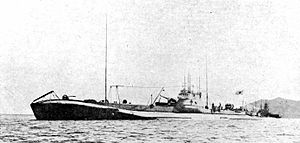Japanese submarine I-55 (1925)

I-55 in harbor in 1930
|
|
| History | |
|---|---|
|
|
|
| Name: | I-55 |
| Builder: | Kure Naval Arsenal |
| Laid down: | 1 April 1924, as Submarine No. 78 |
| Launched: | 2 September 1925 |
| Completed: | 5 September 1927 |
| Renamed: | 20 May 1942, as I-155 |
| Struck: | 20 November 1945 |
| Fate: | Sunk as target 8 May 1946 |
| General characteristics | |
| Class and type: | Kaidai-class submarine (KD3A Type) |
| Displacement: |
|
| Length: | 100 m (328 ft 1 in) |
| Beam: | 8 m (26 ft 3 in) |
| Draft: | 4.82 m (15 ft 10 in) |
| Installed power: |
|
| Propulsion: | |
| Speed: |
|
| Range: |
|
| Test depth: | 60 m (200 ft) |
| Complement: | 60 |
| Armament: |
|
The Japanese submarine I-55, later redesignated I-155 (伊号第五五潜水艦 I-gō Dai-Hyaku-gojūgosensuikan) , was a Kaidai-class cruiser submarine of the KD3A sub-class built for the Imperial Japanese Navy (IJN) during the 1920s. She saw service throughout World War II.
Following World War I, the Imperial Japanese Navy re-evaluated the use submarine warfare as an element of fleet strategy due to the successful deployment of long-range cruiser-submarines for commerce raiding by the major combatant navies. Japanese strategists came to realize possibilities for using the weapon for long range reconnaissance, and in a war of attrition against an enemy fleet approaching Japan. Two large, long-range Japanese submarines had already been built under the Eight-six fleet program as prototype (I-51 and I-52), however, the arrival on 20 June 1919 of seven German U-boats received by Japan as war reparations at the end of World War I led to a complete re-design. The Japanese quickly hired hundreds of German submarine engineers, technicians and former U-boat officers unemployed by the defeat of Germany in World War I, and brought them to Japan under 5-year contracts. The American ONI (Office of Naval Intelligence) estimated that some 800 German advisors had gone to Japan by the end of 1920. The Japanese also sent delegations to Germany, and were active in purchasing many patents.
The four Kaidai Type 3a vessels were the first mass-produced Japanese fleet submarines. Based largely on the indigenous Kaidai Type II (I-52) a strengthened double hull, their design was also influenced by the largest of the German submarines in Japanese hands, the SM U-125. The hull had almost the same outer dimensions as the I-52, but the increased thickness of the inner hull permitted a diving depth of 60 meters. Internal volume was slightly increased by making the hull slightly trapezoidal in cross-section, at the expense of 300 tons of additional displacement. External differences included an anti-submarine net cutter on the bow, as well as an O-ring for towing purposes.
...
Wikipedia
